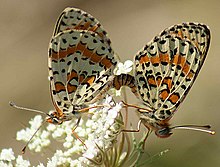Copulation (zoology)
In zoology, copulation is animal sexual behavior in which a male introduces sperm into the female's body, especially directly into her reproductive tract.
[7] For primitive insects, the male deposits spermatozoa on the substrate, sometimes stored within a special structure; courtship involves inducing the female to take up the sperm package into her genital opening, but there is no actual copulation.
[8][9] In groups that have reproduction similar to spiders, such as dragonflies, males extrude sperm into secondary copulatory structures removed from their genital opening, which are then used to inseminate the female.
[10] In advanced groups of insects, the male uses its aedeagus, a structure formed from the terminal segments of the abdomen, to deposit sperm directly (though sometimes in a capsule called a spermatophore) into the female's reproductive tract.
[12][13] These behavioral states correlate with the phases of the human sexual response cycle: motivation − excitement; consummation − plateau and orgasm; satiety − refraction.
In most female mammals, the act of copulation is controlled by several innate neurobiological processes, including the motor sexual reflex of lordosis.
